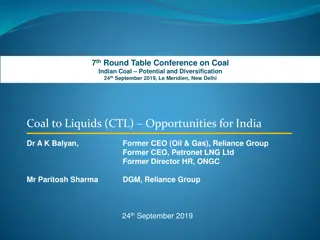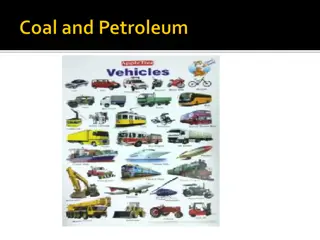Unveiling the World of Fossil Fuels: Coal Formation and Usage
Exploring the formation of fossil fuels, particularly coal, from ancient plant remains buried under the Earth's surface over millions of years. Learn about the transformation process from peat to brown and black coal, and how coal is utilized as a valuable fuel source for electricity generation and steel production.
Download Presentation

Please find below an Image/Link to download the presentation.
The content on the website is provided AS IS for your information and personal use only. It may not be sold, licensed, or shared on other websites without obtaining consent from the author.If you encounter any issues during the download, it is possible that the publisher has removed the file from their server.
You are allowed to download the files provided on this website for personal or commercial use, subject to the condition that they are used lawfully. All files are the property of their respective owners.
The content on the website is provided AS IS for your information and personal use only. It may not be sold, licensed, or shared on other websites without obtaining consent from the author.
E N D
Presentation Transcript
PRECIOUS RESOURCES Fossil Fuels
Among the natural resources below the Earth's surface is a reserve of energy in the form of fossil fuels. The energy stored in fossil fuels comes from the remains of ancient plants and animals, buried under layers of the Earth's crust that have built up over tens or hundreds of millions of years. When we burn fossil fuels coal, oil and natural gas the stored energy is converted to other forms of energy, including heat, movement and light.
DEAD AND BURIED Coal is formed from the remains of ancient plants. Millions of years ago, much of the land on Earth was covered with warm, humid forests and swamps. When trees and plants died, they were buried by layers of other dead plants before they could rot. As the layers of rotting material built up in the forests and swamps, they were compressed under the weight of other plants and water. Over millions of years, the weight and high temperatures drove moisture out of the plant remains. The plant matter left behind is known as peat.
BROWN AND BLACK As areas were flooded by swollen rivers or changes in sea level, sediments of gravel, sand, mud or silt covered the rotting vegetation. Over time, as they were buried under other layers, these sediments changed into rocks known as sedimentary rocks. If the swampy conditions returned, more layers of rotting plants and peat formed and were covered. Over millions of years, the peat was compressed by the weight of the layers above and became warmer. Much of the remaining moisture was driven out, forming brown coal (lignite). As the compression continued and more moisture was driven out, the harder and drier black coal (anthracite) was formed.
COAL AS A FUEL More than three-quarters of the black coal mined in Australia is exported. Most of the remainder is used to generate electricity in power stations. Some of the Page 241black coal is used in the production of steel and as briquettes for heating. The majority of Australia's brown coal mines are in Victoria, where most of the coal is used to generate electricity. Black coal provides more energy than the same amount of brown coal, mainly because it contains less water. In some countries peat is used as a fuel. However, it has to be dried first. In Ireland, where there is very little coal or oil, peat is used to generate electricity.
AT THE COAL FACE In Victoria, the major reserves of brown coal are found in the Latrobe Valley, where more than 80 per cent of Victoria's electricity is generated. Because the coal is close to the surface, the open-cut method is used to mine it. Rock, soil and vegetation (the overburden) are first removed by bucket wheel excavators to expose the coal. Bucket- shaped excavators load the coal onto conveyors, which transport it to the power-station boilers. When the coal is deeper, it must be mined underground. Underground mining is more costly than open-cut mining. Underground mining is also quite dangerous. As well as the threat of cave-ins and flooding, layers of coal contain poisonous methane gas. Another poisonous gas, carbon monoxide, is also often produced when explosives are used underground. The dust produced by the coal not only damages miners' lungs, but also forms an explosive mixture with methane gas. Proper ventilation systems in underground mines are needed to minimise these dangers.
HOW ABOUT THAT! Almost one-quarter of the crust that makes up the Australian continent contains coal of one type or another. Australia has approximately five per cent of the world's known reserves of black coal and approximately 16 per cent of the world's known reserves of brown coal.
A bucket-wheel excavator at Yallourn in Victoria can remove 2300 tonnes of brown coal in one hour.
THE GOOD OIL Oil and natural gas are believed to have formed from the remains of tiny sea animals and plants. These organisms were buried in sediments at the bottom of the oceans millions of years ago. As these plant and animal remains slowly decomposed, they were compressed by water and the layers of sediment that formed above them. Chemical reactions gradually changed them into oil and natural gas, which then seeped upwards through some layers of sedimentary rocks. Such rocks are described as porous. The oil and gas were eventually trapped by rock layers that would not allow them to seep through (non-porous rock). The oil taken from beneath the Earth's surface is converted in oil refineries into a number of different fuels, including diesel fuel, petrol and kerosene products. Natural gas is mainly used for heating and for cooking. Australia's biggest oil and natural gas reserves lie under the seabed in Bass Strait off the coast of Victoria and on the North West Shelf off Western Australia. The layers are folded by rocks beneath the surface pushing against each other. Sometimes the forces are great enough to crack rocks so that layers slide up or down.
Australia's oil and gas reserves
The trapping of oil and natural gas by layers of non-porous rock usually occurs as a result of the bending, cracking and movement of rocks beneath the surface.
WARNING, WARNING! Fossil fuels are non-renewable resources. To say that they are being used up more quickly than they are replaced is an understatement. Until the Industrial Revolution began a little more than 200 years ago, Page 243the use of fossil fuels was rare; since then, it has increased steadily. It wasn't until the 1970s that the prediction was made that, if this rate of increase continued, all known fossil fuel supplies could be used up by early in the twenty-first century. Since then, most developed nations, including Australia, have encouraged the use of renewable resources such as solar, wind and tidal energy.
An oil rig off the coast of Australia. Oil companies drill down through the layers of rock to tap oil reserves. The large red and white pylons extend down to the ocean floor. The drilling bit and oil pipe are fed down through the tall tower.
VIDEOS Cooper Pedy























